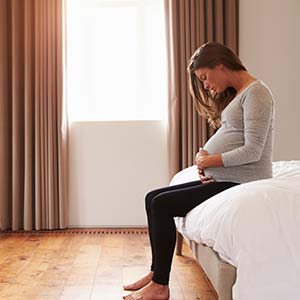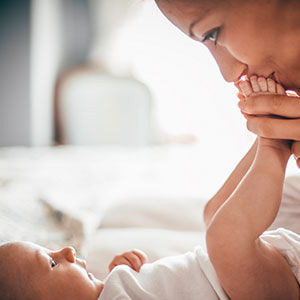Every parent wants their child to be healthy, to flourish and learn. One of the keys to a child’s success in life starts with eye health and good vision. It may sound obvious, but in order to learn, a child must first be able to see clearly. However, many eye conditions, like nearsightedness, can go undetected, as children tend not to complain or even notice that something isn’t right. Instead, they just adjust.
Children’s eyes and vision change as they grow. Therefore, babies, children, and teenagers have different eye health considerations at each stage. Regular eye doctor checkups are important to ensure that your child has no uncorrected eye conditions or vision problems that can be either dangerous or a barrier to growth and learning.
The American Optometric Association recommends an initial eye exam at six months, another at age three, the next before starting first grade, and then every two years through age 18. (1)
Babies, infants, and toddlers
Through the first six months of life, a baby’s vision evolves rapidly. Newborns begin to focus on an object within the first several weeks of life, and by two months they can follow moving objects with their eyes. At birth, they are very sensitive to bright light, but by two weeks they start seeing shades of light and dark. Around the one-month mark, they begin to recognize colors.
When they reach six months old, it’s time to schedule your child’s first eye exam. The eye doctor will conduct a vision test and a comprehensive eye exam, checking for proper eye movement, alignment, and the ability to track light and color, plus they’ll look for signs of common disorders like amblyopia, commonly known as “lazy eye.”
Vision problems in babies, infants, and toddlers are rare. Nevertheless, if your child shows signs of any of the following, schedule an appointment with your pediatrician or eye doctor, as vision and eye problems can delay development.
- Excessive tearing. This could indicate blocked tear ducts.
- Squinting. This could indicate amblyopia, or “lazy eye”.
- Chronic redness in the eye. This could be a sign of an eye infection.
- Constant eye rubbing. This could be a sign of an eye infection.
- Eyes that do not appear to work together. This may be an indicator of crossed eyes (strabismus) or lazy eye (amblyopia).
Pre-school (ages 2-5)
Focusing, tracking, depth perception, and other aspects of vision continue to develop throughout early childhood. Regular checkups will ensure that your child’s development is normal.
The American Public Health Association reports than one in four children have some form of vision problem or condition. (2) However, children this age usually don’t complain about their vision problems, so parents should be aware of the signs:
- Looks cross-eyed, or eyes don’t work in unison
- Closes one eye while reading or examining an object
- Tilts the head when looking at something
- Rubs eyes when not sleepy
- Excessive tear production
- Overly sensitive to light
- Squinting, sitting very close to the TV, or holding a book too close
- Redness in eyes, sometimes accompanied by pain or light sensitivity
Children and teenagers (ages 6 to 18)
As children reach school age, they may develop some common conditions that can be easily corrected with glasses or contact lenses:
- Farsightedness, the difficulty in seeing close-up.
- Nearsightedness, the difficulty in seeing objects in the distance.
- Astigmatism, when vision is distorted or blurred for both near and far objects. Sometimes, an astigmatism is combined with nearsightedness.
As a parent, be alert for symptoms that may indicate your child has one of these vision or visual processing problems. Make an appointment with your optometrist if you notice any of the following, which could be signs that your child needs corrective lenses:
- Avoiding close work
- Holding reading material too close to the eyes
- Headaches
- Eye rubbing
- Losing their place while reading
- Tilting head and using one eye only
- Using finger to maintain place while reading
- A drop in grades and performance, or other indications from teachers that they may be having trouble seeing in the classroom.
1. http://www.aoa.org/patients-and-public/caring-for-your-vision/comprehensive-eye-and-vision-examination/recommended-examination-frequency-for-pediatric-patients-and-adults?sso=y
2. https://www.apha.org/policies-and-advocacy/public-health-policy-statements/policy-database/2014/07/08/15/29/reducing-barriers-and-increasing-access-to-childrens-vision-care-services





